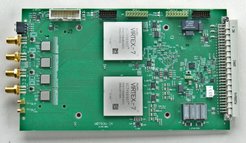qFFTS4G
A new quad-input FFTS board for 4 × 4 GHz bandwidth
This development is part of the SFB 956 “Cosmic Cycle of Star Formation”, which investigates the complex interplay between star formation and its embedding interstellar medium (ISM). The DSP division is responsible for the work package D4 - Digital Signal Processing, which is a R&D package focusing on the exploration of new developments of digital signal processing techniques at highest time-rates and of the implementation of a digital, high-resolution and wide-band Fast Fourier Transform Spectrometer at the new CCAT-prime telescope in Chile.
In particular, the large size of the heterodyne array receiver CHAI at CCAT-prime telescope will drive the R&D developments. Especially with array receivers like CHAI, special emphasis on the system design and compactness of all components are essential to build a spectrometer system at all. As a consequence, compared with earlier FFT developments, the new spectrometer uses a considerably simplified IF part of CHAI and generates additional information to operate the receiver system (e.g. tuning and IF leveling).

Photo of the final qFFTS4G spectrometer board. The qFFTS4G enables spectroscopic signal analysis of 4 × 4 GHz in 4 × 64k channels. It is able to directly sample baseband signals (0-4 GHz), but also IF signals in the range 4-8 GHz. Thanks to a newly developed 1 Gbit/s Ethernet interface based on a Xilinx Zynq7 FPGA with ARM microprocessor, spectra can be transmitted with full channel count at up to 50 Hz.
In details, the usual down conversion of the signal by analog mixing of the IF bandwidth (4–8 GHz) to baseband (0–4 GHz), needs to be eliminated because the analog IF signal processors are time-consuming to build, cost intensive and not free of calibration and aging. This step has been circumvent by using a new RF-ADC from Texas Instruments, which can sample analog signals from DC to 8 GHz, and therefore enables direct bandpass sampling and thus significantly simplifies the analog IF processing chain. To further simplify the IF processing, the analog total-power detectors are not used in the CHAI IF processing. Instead, the new FFT spectrometer will provide the total-power information digitally and analog for IF leveling and mixer tuning, respectively.
The picture shows the finished and thoroughly evaluated qFFTS4G spectrometer board and a total of 35 qFFTS4G boards for the CHAI receiver of the new CCAT-prime telescope has been produced and successfully tested in the laboratory.
In addition, to the hardware developments a new method to calibrate time-interleaving ADCs in the Fourier domain has been developed. Time-interleaving method is based on high-speed ADCs, operating in the GHz range, which all samples the same input signal, but using individual ADC cores with a phase offset. Because this technique enables a single ADC core to operate at lower frequencies, these GHz-ADCs can be built out of silicon, which makes this process possible at all. Although many manufacturers of high-speed ADCs integrate automatic time interleaving in their chips, these automatic methods cannot meet the high demands in radio astronomy. Especially this is an issue for higher Nyquist bands (e.g. like the qFFTS4G project), where an extremely accurate adjustment of offset, gain, and phase is needed and due to the frequency dependent behavior of gain and phases, a mismatch would impact on the dynamic range of the spectrometer.

A new method was developed, simulated, and tested that is based on the complex amplitude spectrum after the Fourier transformation step. For this purpose, a test signal (e.g. a sinus every 10 MHz) is fed into the ADC chip and phase and gain mismatch at the applied calibration frequency are extracted from each ADC core spectrum. From the measured mismatches the calibration parameters are calculated based on a model of a time-interleaved ADC composed of ADC cores with frequency dependent gain and phase. The calibration is then applied to the complex amplitude spectra of each individual ADC core. In order to reduce FPGA resource usage, the last step of the FFT procedure is incorporated into the calibration process. The impact on the resulting spectra of this new calibration method is shown in the diagram. The impact of the standard calibration method (frequency independent; purple curve) is only visible at the frequency at which the calibration was performed (in this case around 2 GHz), whereas with the new post-FFT method (orange and yellow curve), the entire spectrum is aligned and the dynamic range, even in the second Nyquist band, is up to 20 dB better than the previous method.
With the newly developed frequency-dependent calibration scheme (post-FFT method), the mirror frequency suppression of our next generation FFT spectrometers (qFFTS4G) can be significantly improved. It is now possible to directly sample the second Nyquist band, which will be an important asset in further cost-limited projects (e.g. CHAI for CCAT-prime or an extension of the upGREAT heterodyne array). Furthermore, the same technique can be applied to digitally correct and improve the sideband separation of SSB and 2SB mixer receivers.

